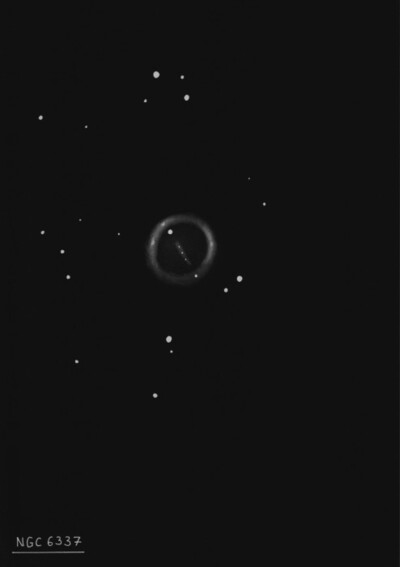
John Herschel discovered NGC 6337 = h3680 on 28 Jun 1834 and recorded an "Annular Nebula. A delicate, eF, but perfectly well defined annulus 15-20" diameter. The field crowded with stars, two of which are on the nebula (see figure 3, Plate VI.)" A later observation records "A beautiful delicate ring, of a faint ghost-like appearance, about 40" diameter; in a field of about 150 stars, 11 and 12 mag and under. In it is one *12 mag very conspicuous, and one 15 mag much less so. Near it are two stars 14 and 15 mag, and south of it at distance 60" is another."
Using his 48-inch from Malta, William Lassell also sketched a thin, perfectly symmetric ring with a star "perhaps 10.5 or 11 magnitude" on the north side and a faint one embedded on the south rim. Joseph Turner made a similar sketch in 1874 with the 48-inch Great Melbourne Telescope (plate VII, figure 75, unpublished) as well as Pietro Baracchi in Sept. 1884 with the GMT.
The 5 superimposed stars were described in the 1921 Helwan Observatory list (based on photos taken in 1914-16) as follows: "Along a diameter of the ring in p.a. 25° is a line of stars, so straight as to suggest some connection with the nebula rather than a chance superposition. The two brightest stars are at opposite ends of this line, that to the north being just inside the ring and the south one on the ring itself. Between the central star and this south star is first (distant 5" from the former) a star 17-18 mag, and then either a still fainter star or possibly a small piece of nebulosity."
300/350mm - 13.1" (5/30/87): at 166x with a UHC filter appears fairly faint, fairly small, roundish. Slightly darker center (annular) with averted vision although the contrast with the rim is low due to the elevation. No central star seen.
13.1" (7/5/83): at 144x-166x appears fairly small, faint but fairly easy, darker center (annular), somewhat like a smaller and dimmer version of M57.
400/500mm - 17.5" (6/30/00): very pretty annular planetary at 280x, ~45" and set in a rich star field. A mag 12 star is superimposed on the inner edge of the NE rim and an extremely faint star is symmetrically placed at the SW edge. The darker hole is 20"-25" diameter and perfectly circular. The outer rim appears irregularly lit.
Notes by Steve Gottlieb